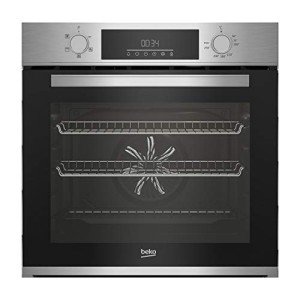There Is No Doubt That You Require Electric Single Oven
Understanding Electric Single Ovens: A Comprehensive Guide
Electric single ovens have become significantly popular amongst home cooks and professional chefs alike. Their performance, constant cooking outcomes, and flexibility make them an essential kitchen appliance. This guide will look into the numerous functions of electric single ovens, their advantages, and considerations for purchasing one.
What is an Electric Single Oven?
An electric single oven is a standalone cooking system that runs utilizing electricity rather than gas. These ovens are developed to fit within a kitchen cabinet or as a standalone system. As the name suggests, they include a single cooking compartment, permitting for a variety of cooking methods such as baking, broiling, and roasting.
Secret Features of Electric Single Ovens
Electric single ovens come geared up with a series of functions that enhance cooking. Here's a list of some vital characteristics:
- Temperature Control: Most electric ovens have exact temperature level control settings which permit more accurate cooking.
- Cooking Modes: Common cooking modes consist of convection, broil, bake, and self-cleaning options.
- Self-Cleaning Function: Many designs offer a self-cleaning function that makes upkeep easy.
- Built-In Timers: Timers help home cooks keep an eye on their cooking times, ensuring that food is not overcooked.
- Digital Displays: An easy to use digital display permits easier adjustments and monitoring of cooking procedures.
Function
Description
Temperature Control
Adjustable settings for accuracy cooking
Cooking Modes
Different modes geared towards different cooking strategies
Self-Cleaning
Automated cleansing cycles for convenience
Built-In Timers
Timers for ideal cooking time management
Digital Displays
Clear and user-friendly interfaces for simple usage
Kinds Of Electric Single Ovens
Electric single ovens come in various types, each accommodating various cooking preferences. Below is a summary of typical electric single oven types:
Conventional Ovens: These ovens supply a traditional heating approach using heating components at the top and bottom.
Convection Ovens: Featuring a fan, these ovens distribute hot air, resulting in much faster cooking times and more even browning.
Steam Ovens: Utilizing steam, these ovens protect moisture and nutrients, making them ideal for health-conscious cooking.
Wall Ovens: Installed within kitchen cabinets, wall ovens save area and provide a streamlined look.
Range Ovens: Typically combined with cooktops, range ovens supply an all-in-one cooking service but require more kitchen space.
Advantages of Electric Single Ovens
Electric single ovens provide many benefits, making them a preferred among many homeowners. Here are some essential advantages:
Energy Efficiency: Electric ovens are often more energy-efficient than gas ovens, consuming less energy while offering excellent cooking outcomes.
Consistent Cooking: Electric models supply even heat distribution, getting rid of locations that can lead to uneven cooking.
Alleviate of Use: Features such as pre-set cooking modes and digital controls streamline the cooking procedure, making it available to cooks of all ability levels.
Versatility: From baking bread to roasting veggies, electric single ovens can accommodate a wide variety of cooking methods and dishes.
Considerations When Buying an Electric Single Oven
Before acquiring an electric single oven, it is necessary to think about several elements to ensure the best choice for your kitchen:
Size: Measure the space where the oven will be set up. Guarantee that it fits your kitchen cabinetry and leaves room for correct ventilation.
Cooking Capacity: Choose an oven with adequate interior area to manage your cooking needs, specifically if you often cook for large households or events.
Functions: Assess the types of cooking modes and features that are very important to you, such as self-cleaning choices and wise technology.
Brand Reliability: Research trustworthy brands with positive evaluations, as quality can differ considerably between manufacturers.
Budget plan: Electric single ovens come in a large range of costs. Set a spending plan that reflects both your cooking requirements and your monetary capacity.
Frequently Asked Questions About Electric Single Ovens
What is the difference between electric and gas ovens?
- Electric ovens utilize electricity to generate heat, providing even cooking and often needing less maintenance. Source utilize natural gas, which some users prefer for the instant heat and temperature control.
Do electric single ovens prepare food quicker than gas ovens?
- Electric ovens typically supply more consistent heat, which can lead to quicker cooking times under particular conditions. However, the specific cooking time also depends upon the particular oven's features and style.
Is it tough to clean up an electric single oven?
- Many electric single ovens come with self-cleaning choices, making the cleaning procedure a lot easier. For those without this feature, regular maintenance and wipes can keep ovens in great condition.
Can I use aluminum foil in an electric oven?
- Yes, aluminum foil can be used in electric ovens. However, it's best to prevent lining the bottom of the oven with foil as it may affect heat blood circulation and damage the heating components.
Exist smart functions readily available with electric single ovens?
- Numerous contemporary electric single ovens come geared up with wise functions that can connect to Wi-Fi, permitting users to manage cooking settings from their mobile phones.
Electric single ovens offer a useful and efficient cooking service for any kitchen. With flexible cooking choices, easy to use features, and a range of models to choose from, finding the right electric single oven can boost the cooking experience. By considering individual cooking requirements and preferences, customers can make an informed decision that will match their cooking undertakings for several years to come.
Ultimately, updating to an electric single oven can be a transformative choice, streamlining meal preparation while making it possible for a selection of cooking possibilities.
